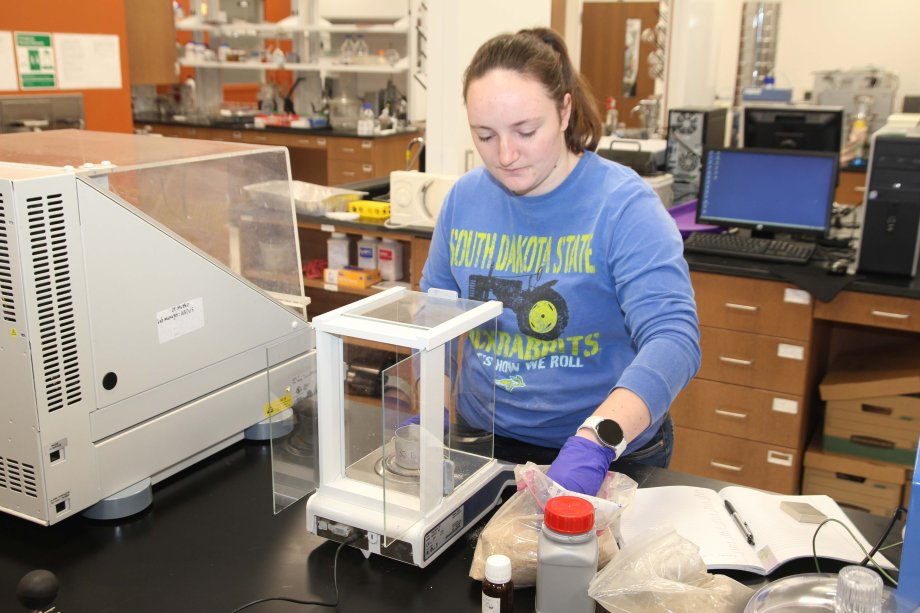
Editor’s note: Jackrabbit in the Spotlight is a monthly feature in Engineering Connection that gives a glimpse at a successful undergraduate or graduate student in the Lohr College of Engineering.
Student researcher Magdalene “Maggie” Hoff is more comfortable working in the Food Processing and Extrusion Wet lab in Raven Precision Agriculture Center than in the center of the Capitol Rotunda, but that is where she will be Feb. 29.
Hoff, a senior agriculture and biosystems engineering major from Gillette, Wyoming, was one of two South Dakota State University students chosen to give research poster presentations in Pierre. The other is Kaitlyn Preszler, a natural resources management student. They will be joined by students from each of the other South Dakota Board of Regents institutions.
She admits to being nervous about talking to state legislators, “but it will be interesting to hear their perspectives.”
The research she will present is a study on the effectiveness of making magnetic-activated carbon from crop residue to absorb pollutants in wastewater from meat processing facilities. Hoff has been incinerating corn stover and soybean residue, adding magnetic elements and then testing it in the lab.
This is the second year she has worked on the project under the supervision of Muthu Muthukumarappan, a distinguished professor and the Klingbeil Endowed Department Head of the Department of Agricultural and Biosystems Engineering.
Also a future innovator
In both years, Hoff has been chosen as a Future Innovator of America fellow by the Lohr College of Engineering. That provides her with $4,500 as a stipend and $500 to cover the cost of lab supplies or travel to disseminate the results of their project. The fellowships were created to provide unique research opportunities for undergraduate students in the college.
“I started working on experiments in January 2023 and successfully made some magnetic-activated carbon out of corn residue and started testing how well it will do. I used methylene blue absorption, a concentrated dye, as the test pollutant and an iodine absorption test. From that testing, I can estimate what it might be able to absorb out of wastewater,” Hoff said.
From there she wrote a paper and presented it at the annual conference of the American Society of Agricultural and Biological Engineers in Omaha last summer.
This winter she would like to create magnetic-activated carbon that has higher absorption capabilities and then complete lab testing demonstrating that. “The goal is that nitrates and phosphates could be absorbed. Preliminarily, based on the product’s surface area, it should be able to absorb nitrate and phosphates,” Hoff said.
Five grams at a time
Testing has been at a small scale. Five grams of crop residue are burned down to 1.5 to 2 grams and combined with trace amounts of magnetic particles.
“You want it to burn off everything but the carbon when processing it. It is a fine powder when it comes out of the furnace. I use a mortar and pestle to grind the ash and then put it in a coffee grinder to get it to a finer particle size, which has better absorption than coarser particles,” she said.
While meatpacking plants are already treating their wastewater to U.S. Environmental Protection Agency standards, there is still room for improvement, Hoff said.
She has been interested in food and bioprocessing engineering since an internship with Valley Queen Cheese in Milbank her sophomore year. She started doing research in the Department of Agricultural and Biosystems Engineering in August 2022 and found she liked it.
As to her current work, Hoff explained, “I started looking into things I’m interested in. I discovered other research on magnetic-activated carbon for textile dyes and antibiotics, but those used coconut shells and peanut hulls. I wanted to use corn and soybean crop residues, something we have very readily in our area.”
While she been under the hand of Muthu, it has been a distant hand, which has been a challenge and a blessing.
“The biggest thing is I’ve done the actual experiments on my own. I’ve had to figure things out on my own. You learn a lot from the mistakes you make. A lot of trial and error,” Hoff said. Among the things she has learned is to limit the oxygen that gets into the carbon during incineration.
She also has learned a lot about testing procedure standards.
Next stop: Sioux City
Hoff still has a lot to learn in the remainder of her final semester. One is what the legislators will think of her project. One of the points that she will emphasize is that the magnetic-activated carbon could create a market for what is now an unused waste product. “Farmers could have another source of income from their crops, and this is important for our environment.”
After Research Day at the Legislature, it is back to the lab for a couple months and then on with life.
Hoff, who has spent many hours on her family’s cow and sheep ranch near Faith in western South Dakota, has accepted a job with Empirical Foods in South Sioux City, Nebraska. She will start as a management trainee and then transition to a manufacturing process engineer at the firm, which makes packaged steaks and ground beef from large meat cuts.
In summer 2023, the bioprocessing minor had an internship in the food science department at the University of Tennessee in Knoxville.
- Contact:
- Telephone number: 605-688-4538
Republishing
You may republish SDSU News Center articles for free, online or in print. Questions? Contact us at sdsu.news@sdstate.edu or 605-688-6161.

